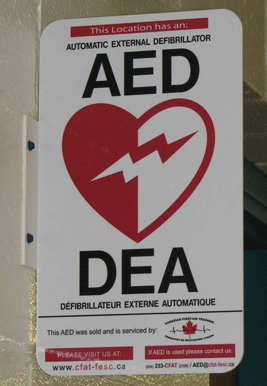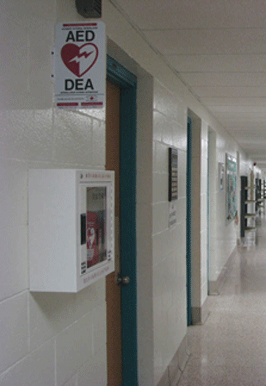Questions and Answers about The Defibrillator Public Access Act
1. Which public places are required to install an AED?
Based on expert advice and public feedback, several types of high traffic public places where cardiac arrest is more likely to occur have been designated, such as gyms, arenas, community centres, golf courses, schools and airports. For a complete list, please click here.
Additional public places may be added in the future as more information and advice becomes available.
2. When do AEDs have to be installed in designated public places?
Owners of premises designated under the Act were required to install AEDs in their premises by January 31, 2014.
3. What types of AEDs are acceptable to comply with the Act?
A semi-automated external defibrillator approved by Health Canada must be used to comply with the Act. A semi-automated defibrillator recognizes the presence of an irregular heart rhythm and determines whether a defibrillation shock is required. If a shock is required, it automatically charges and alerts the operator to deliver the charge. Acceptable semi-automated defibrillators must be suitable for use on both adults and children and have an extra set of pads. The device must also be equipped with a blinking light, chirping sound or other indicator to signal when maintenance is necessary.
More information on the types of AEDs that are acceptable in Manitoba can be found by clicking here.
4. Where does the AED have to be installed?
The AED must be installed in a location that facilitates easy, rapid public access. It must be clearly visible, located in a common area and easily accessible to members of the public without assistance from staff at the facility.
The AED should be stored in a case that protects it from environmental damage. Some cases are equipped with alarms to help prevent tampering and ensure the AED is only used in an emergency.
Further advice on installation is available from Shared Health and AED distributors will also generally offer advice as well.
5. What type of signage is required?
The Act and Regulation require that the owners of designated premises post signs alerting the public about the presence of an AED in the facility at the entrances to the facility, near the AED device itself and wherever the owner considers necessary to ensure the public will be made aware about the presence of the AED. The signs themselves need to be on contrasting colours and contain a heart with a lightning bolt through it, and contain the text "AED" or "Automated External Defibrillator". The signs also need to include text advising as to the location of the AED (unless the sign is adjacent to the AED itself). French and bilingual signs that contain the required graphics are also permitted.
 |
 |
Signage is generally available from AED distributors.
6. How do I register the AED after it is installed?
Once installed, AEDs must be registered with Shared Health, who acts as the registrar. This registry is shared with 911 dispatchers so they can assist a caller in an emergency with locating the nearest AED.
For more information on how to register your AED, please visit the Shared Health AED registry page.
Please note: if an AED is moved or removed for any reason, the owner of a designated facility must notify Shared Health within 15 days.
7. How many AEDs do I have to install?
Generally, the “three-minute rule” is used to determine where and how many AEDs are required. While research indicates that AEDs are optimally beneficial if used within three-minutes of the onset of sudden cardiac arrest, it is realized that a three-minute rule of access may not always be possible.
The Regulation therefore requires that the owners of designated premises install one or more defibrillators as may be necessary to ensure that a member of the public witnessing a victim of cardiac arrest at any public location on the premises is able to access a defibrillator and return to the victim in less than three minutes. "Any location on the premises" does not include outdoor areas of indoor designated premises, outbuildings not ordinarily accessed by members of the public, or parking lots or parking structures located on the same property as, or adjacent to, the designated premises.
The owner of a designated premises is responsible for determining, after having considered the area and layout of the facility, if the necessary number of AEDs have been installed. In considering the layout of the premises, the owner’s considerations must include the locations of stairways, elevators, ramps, number of floors, accessibility by members of the public to different areas during regular operating hours and other unique design features. Finally, the owner of a designated premises may assume that a member of the public has a walking speed of approximately 100 m/min.
Special consideration was made for certain outdoor designated premises due to land area coverage, such as golf courses and the Assiniboine Park Zoo. They are excluded from the three-minute rule requirement, but must ensure AEDs are available at specific locations set out in the Regulation.
Survival rates fall dramatically – seven to 10 per cent - with every minute that passes between the onset of a sudden cardiac arrest and defibrillation. The three-minute rule of access has therefore been implemented to the fullest extent possible to maximize the benefit offered by AEDs.
8. Are there any maintenance/inspection requirements?
Yes. AEDs should be inspected monthly in accordance with the manufacturer’s guidelines. When a monthly inspection is completed, it must be noted on the inspection tag that is to be attached to the defibrillator over a 12 month period. The inspection must also be logged in a monthly inspection record which records must also be kept for at least 12 months. The Regulation contains the items to be noted in the inspection tag and monthly inspection record.
9. Does the Act state that only certain people or companies can inspect and maintain an AED?
No, the Act requires that the owners of designated premises maintain their AEDs in accordance with the requirements of the Regulation, which involves inspecting it once a month and attending to it whenever the AED indicates that servicing is necessary – for example by emitting a blinking light or chirping sound. The owners must then ensure that inspection records are kept and maintained for a year. The owners can make their own arrangements as to who inspects and maintains the AED – it could be the owners themselves or an authorized employee or agent. The intention behind the Act is to ensure that AEDs are in working order so that they work properly when needed. There is no intention to limit rights of maintenance and inspection to anyone.
10. What kinds of liability risks are associated with AEDs?
The Act provides protection from civil liability to the owners or occupiers of premises where an AED is made available for use and who act in good faith with respect to the availability or use of the AED for any harm or damage that may occur from the use or attempted use of the AED. Similarly, a user of an AED is protected from civil liability if he or she uses it in good faith.
11. Is special training required in order to operate an AED?
No, anyone can safely use an AED without training, provided that the user can read the AED's text and follow its voice-prompt instructions. The AED assesses the heart of a person in cardiac arrest for a shockable rhythm. If such a rhythm is detected the AED requests the rescuer to push a button to deliver a shock to a victim’s heart. If no shockable rhythm is detected, no shock will be requested nor can a shock be given. The Act is not intended to prohibit anyone capable of reading and following instructions from using an AED.
12. Is a special licence required in order to own an AED?
No special licence is required to own an AED. The Act and Regulation only require the owners of designated premises to register their AEDs with the AED registrar, Shared Health. The information is used to notify 911 services of the locations of AEDs who then use the information to guide the public to them during an emergency.
13. How were the public places designated under The Act selected?
The designation of public premises under the Act will occur in phases, beginning with facilities where people are considered most at risk for sudden cardiac arrest and where an AED is most likely to make a difference and save a life. Recommendations were obtained from an expert advisory group including paramedics and representatives of the Heart and Stroke Foundation in Manitoba. They considered factors such as public traffic flows and public capacity thresholds as well as the types of activities that occur. A review of 911 data was also used to identify the types of places that have seen multiple cardiac arrests in recent years. The Manitoba government also consulted with affected stakeholders and the public.


